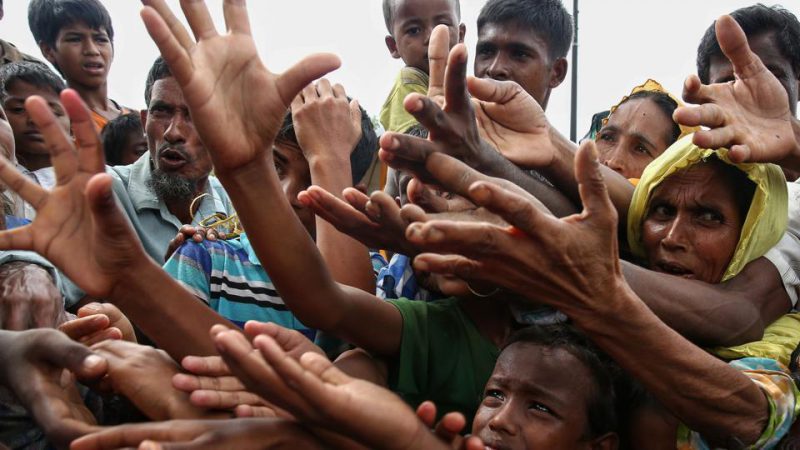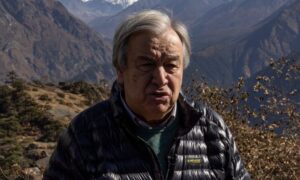
File Picture Courtesy : Hindustan Times
The Muslims of Rakhine (known for centuries as Arakan )state of Myanmar – mostly Sunni and who speak what is called the Chittagongian dialect of Bengali spoken in the adjacent Chittagong district of Bangladesh coined a new term Rohingya to assert their distinct ethnic and religious identity about half a century ago. However, there is no historical evidence of their claim that their identity is rooted in Muslim settlements in Arakan from the 8th century AD.though during 15th – 17th centuries, Arakan had sustained interaction with the Sultanate and the Mughal Nawabs of Bengal. And Arakan’s power- naval and land forces to dominate the coastal and riverine Bengal, was immense as reflected in the way it’s pirates aided by the Portuguese ravaged these areas to obtain slaves for the Global slave market and the fact that Arakan held Chittagong for over a century from around 1580 AD. What we must note that there was no settlement of people from Bengal in Arakan in that era.
The term Rohingya simply means the place where they reside. The British official records suggest that the early Muslims had largely assimilated to the Arakan society because they were small in number and didn’t articulate a separate ethnic status. In the 1872 population census the colonial administration simply recorded them as ‘ Arakan Muslims ‘. In other documents they further distinguished between Burmese Muslims which referred to those who inhabited the land prior to the British rule from 1826 after the defeat of the Burmese king in the first Anglo Burmese war in 1824- 26, and Indian Muslims who came to meet the demands of the colonial administration and more importantly the labor demand of the colonial ” extractive” mode of production.
An insightful 2013 working paper of the International Migration Institute by Cresa Pugh however concluded after painstaking research that” a majority of Muslims living in Rakhine today are descendants of these later migrants from Chittagong’.This large post 1826 influx of new Chittagongian Muslim settlers , Cheung Samuel observed in a 2011 paper in the Journal of Refugee Studies 25 ” drastically altered the dynamics of the two religious communities in Rakhine and large segments of the Buddhist population grew to resent the new comers based on their greater access to labor opportunities and British favouritism.”
The present animosity between the Buddhist Rakhine and the Rohingya really began in the 1950’s when emboldened by the Partition and creation of East Pakistan next door and the ease with which the Hindus of East Pakistan were removed, the Muslim settlers in 1950’s ” started to advocate for the Northern part of Rakhine to become an autonomous Muslim Zone or alternatively merge with East Pakistan.”as observed by Khin Maung Saw in a 2016 study of Arakan.
This created an enduring ” trust deficit” between the Rakhine Buddhists and the Muslims and made full use by junta to demonstrate that only the military could keep the country politically united. The travails of the Rohingyas thus began when the military stripped them of their legal documents and then stigmatized them as foreigners and illegal migrants. Defacto stateless, more than 200,000 Muslims were forced to leave and seek shelter in Bangladesh in 1978. In 1982 the Army led Government enacted a law that deprived all non indegenous settlers who came to Burma after 1824 when the first Anglo Burmese war began of any claim to citizenship which effectively rendered them stateless and hence no protection of law from any form of unjust treatment. Since then, mass exodus of the Rohingyas have been a regular feature which got intensified in 1991, 1992 and since 2012 a regular feature.
According to Bangladesh Government about half a million Rohingya refugees were already lodged in camps in Bangladesh before the crackdown in oct last year and after 25th August this year, over 4 lakhs of Rohingyas have poured into Bangladesh by now; and this means that of the original Rohingya population of about 1. 2 to 3 million in Rakhine only a lakh of people may have been left now in Rakhine – mostly in camps as internally displaced now as a good number of them took refuge in countries in south east Asia and elsewhere.
While this may appear as the UNHCR stated ” a text book case of ethnic cleansing” the root political cause of the problem– Muslim separatism and violent Mujahideen activities aided by the Pak and lslamist forces under the banner of the Arakan Salvation Army for a separate land for the Rohingyas cannot be ignored as it gives an altogether new dimension to the problem. It is thus not just an humanitarian problem but rather an internal political problem of Myanmar that only the parties to the conflict could resolve as it boils down to the issue of citizenship on which depends not only the prospects of the return of the Rohingya Refugees but also the resettlement of the vast internally displaced Rohingya people in their own habitats.
This being the crux of the Rohingya problem, the Global and south Asian governance systems are facing a grave challenge of preventing another ,” Palestine problem” emerging in Asia by sustained efforts to restore trust among the warring groups.
( The writer is a retired IAS officer of the Assam – Meghalaya cadre and has served as Scientific Consultant in the office of the Principal Scientific Advisor to the Government of India)


















